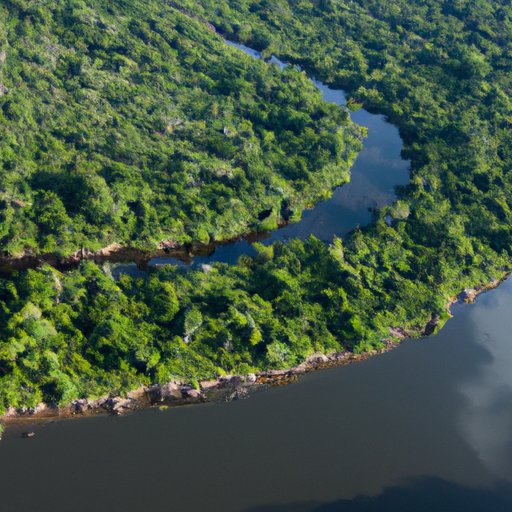Introduction
A rainforest is an area of tall, dense vegetation that typically receives high levels of rainfall throughout the year. These lush ecosystems are home to a wide variety of plants, animals, and even entire cultures. But which rainforest is the largest in the world? The answer is the Amazon Rainforest.
Stretching across nine South American countries, the Amazon Rainforest covers an area of 5.5 million square kilometers (2.1 million square miles). This vast expanse of land is home to an incredible array of plant and animal species, as well as numerous indigenous tribes. In this article, we will explore the Amazon Rainforest in greater detail.
A Comprehensive Guide to the World’s Largest Rainforest
The Amazon Rainforest is located in the northern and western parts of South America, spanning across Brazil, Colombia, Peru, Venezuela, Ecuador, Bolivia, Guyana, Suriname, and French Guiana. At 5.5 million square kilometers (2.1 million square miles), it is the largest rainforest in the world.
The Amazon Rainforest is home to an abundance of plants and animals. There are over 40,000 species of plants, including trees, shrubs, vines, and ferns. There are also around 2.5 million insect species, 3,000 species of fish, 1,294 bird species, 427 mammal species, and 428 amphibian species. The Amazon Rainforest is also home to hundreds of unique indigenous tribes, many of whom rely on the rainforest for their livelihoods.

Exploring the Biodiversity of the Amazon Rainforest
The Amazon Rainforest is home to a wide range of unique plant species. Many of these plants have medicinal properties, and are used by local indigenous tribes for healing purposes. Some of the most notable plants found in the Amazon Rainforest include the rubber tree, the cacao tree, the Brazil nut tree, and the ayahuasca vine.
The Amazon Rainforest is also home to a number of endangered animal species. These include the giant otter, the jaguar, the harpy eagle, the giant anteater, the giant armadillo, and the pink river dolphin. Conservation efforts are underway to protect these species from extinction.

The Role of the Amazon Rainforest in Climate Change
The Amazon Rainforest plays a critical role in global climate regulation. The rainforest acts as a carbon sink, absorbing large amounts of carbon dioxide from the atmosphere and releasing oxygen in return. Deforestation, however, has a significant impact on the global climate. When trees are cut down, they release their stored carbon dioxide into the atmosphere, contributing to global warming.
In addition, deforestation reduces the amount of moisture released into the atmosphere, resulting in less rainfall. This can cause drought conditions in areas downstream of the Amazon forest, impacting local ecosystems and communities.
How the Amazon Rainforest Contributes to Global Health
The Amazon Rainforest also plays an important role in global health. The rainforest is home to thousands of medicinal plants, and many of these plants are used to treat illnesses and diseases. In addition, the Amazon Rainforest is integral to the global nutrient cycle, providing essential nutrients to the soils and waterways of other parts of the world.

An Overview of the Environmental and Cultural Impact of the Amazon Rainforest
Deforestation of the Amazon Rainforest has had a devastating impact on local ecosystems and cultures. The destruction of trees and other plants has resulted in loss of habitat for thousands of species of plants and animals. Additionally, deforestation has impacted the way of life of many indigenous tribes, who rely on the rainforest for their livelihoods.
The Amazon Rainforest is one of the most biodiverse ecosystems in the world. It is home to an incredible array of plants and animals, and plays a vital role in global climate regulation and global health. Unfortunately, deforestation continues to threaten the future of this precious rainforest.
Conclusion
The Amazon Rainforest is the largest rainforest in the world, covering an area of 5.5 million square kilometers (2.1 million square miles). This vast expanse of land is home to an incredible array of plants and animals, as well as numerous indigenous tribes. The Amazon Rainforest plays a critical role in global climate regulation and global health, but deforestation continues to threaten its future.


